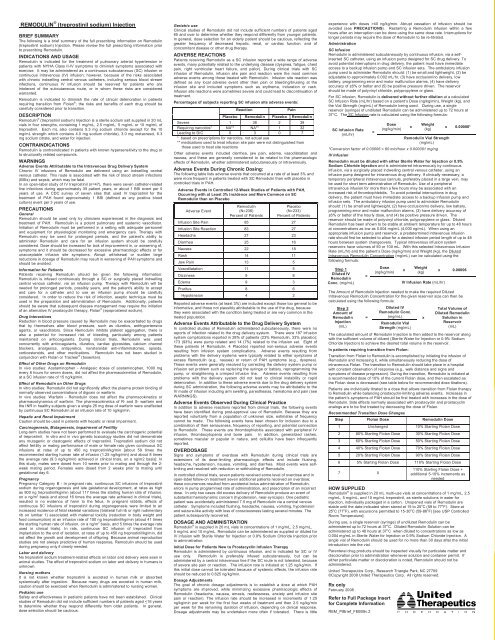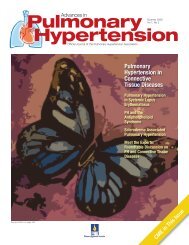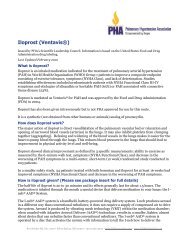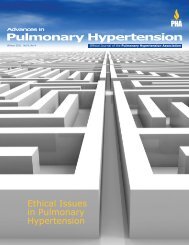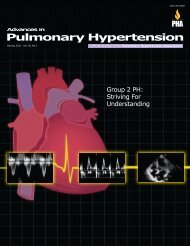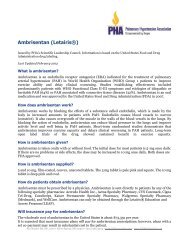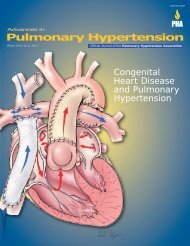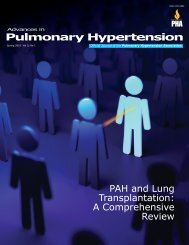Vol 7, No 3 - PHA Online University
Vol 7, No 3 - PHA Online University
Vol 7, No 3 - PHA Online University
You also want an ePaper? Increase the reach of your titles
YUMPU automatically turns print PDFs into web optimized ePapers that Google loves.
REMODULIN ® (treprostinil sodium) Injection<br />
BRIEF SUMMARY<br />
The following is a brief summary of the full prescribing information on Remodulin<br />
(treprostinil sodium) Injection. Please review the full prescribing information prior<br />
to prescribing Remodulin.<br />
INDICATIONS AND USAGE<br />
Remodulin is indicated for the treatment of pulmonary arterial hypertension in<br />
patients with NYHA Class II-IV symptoms to diminish symptoms associated with<br />
exercise. It may be administered as a continuous subcutaneous (SC) infusion or<br />
continuous intravenous (IV) infusion; however, because of the risks associated<br />
with chronic indwelling central venous catheters, including serious blood stream<br />
infections, continuous IV infusion should be reserved for patients who are<br />
intolerant of the subcutaneous route, or in whom these risks are considered<br />
warranted.<br />
Remodulin is indicated to diminish the rate of clinical deterioration in patients<br />
requiring transition from Flolan ® ; the risks and benefits of each drug should be<br />
carefully considered prior to transition.<br />
DESCRIPTION<br />
Remodulin ® (treprostinil sodium) Injection is a sterile sodium salt supplied in 20 mL<br />
vials in four strengths, containing 1 mg/mL, 2.5 mg/mL, 5 mg/mL or 10 mg/mL of<br />
treprostinil. Each mL also contains 5.3 mg sodium chloride (except for the 10<br />
mg/mL strength which contains 4.0 mg sodium chloride), 3.0 mg metacresol, 6.3<br />
mg sodium citrate, and water for injection.<br />
CONTRAINDICATIONS<br />
Remodulin is contraindicated in patients with known hypersensitivity to the drug or<br />
to structurally related compounds.<br />
WARNINGS<br />
Adverse Events Attributable to the Intravenous Drug Delivery System<br />
Chronic IV infusions of Remodulin are delivered using an indwelling central<br />
venous catheter. This route is associated with the risk of blood stream infections<br />
(BSIs) and sepsis, which may be fatal.<br />
In an open-label study of IV treprostinil (n=47), there were seven catheter-related<br />
line infections during approximately 35 patient years, or about 1 BSI event per 5<br />
years of use. A CDC survey of seven sites that used IV treprostinil for the<br />
treatment of PAH found approximately 1 BSI (defined as any positive blood<br />
culture) event per 3 years of use.<br />
PRECAUTIONS<br />
General<br />
Remodulin should be used only by clinicians experienced in the diagnosis and<br />
treatment of PAH. Remodulin is a potent pulmonary and systemic vasodilator.<br />
Initiation of Remodulin must be performed in a setting with adequate personnel<br />
and equipment for physiological monitoring and emergency care. Therapy with<br />
Remodulin may be used for prolonged periods, and the patient’s ability to<br />
administer Remodulin and care for an infusion system should be carefully<br />
considered. Dose should be increased for lack of improvement in, or worsening of,<br />
symptoms and it should be decreased for excessive pharmacologic effects or for<br />
unacceptable infusion site symptoms. Abrupt withdrawal or sudden large<br />
reductions in dosage of Remodulin may result in worsening of PAH symptoms and<br />
should be avoided.<br />
Information for Patients<br />
Patients receiving Remodulin should be given the following information:<br />
Remodulin is infused continuously through a SC or surgically placed indwelling<br />
central venous catheter, via an infusion pump. Therapy with Remodulin will be<br />
needed for prolonged periods, possibly years, and the patient's ability to accept<br />
and care for a catheter and to use an infusion pump should be carefully<br />
considered. In order to reduce the risk of infection, aseptic technique must be<br />
used in the preparation and administration of Remodulin. Additionally, patients<br />
should be aware that subsequent disease management may require the initiation<br />
of an alternative IV prostacyclin therapy, Flolan ® (epoprostenol sodium).<br />
Drug Interactions<br />
Reduction in blood pressure caused by Remodulin may be exacerbated by drugs<br />
that by themselves alter blood pressure, such as diuretics, antihypertensive<br />
agents, or vasodilators. Since Remodulin inhibits platelet aggregation, there is<br />
also a potential for increased risk of bleeding, particularly among patients<br />
maintained on anticoagulants. During clinical trials, Remodulin was used<br />
concurrently with anticoagulants, diuretics, cardiac glycosides, calcium channel<br />
blockers, analgesics, antipyretics, nonsteroidal anti-inflammatories, opioids,<br />
corticosteroids, and other medications. Remodulin has not been studied in<br />
conjunction with Flolan or Tracleer ® (bosentan).<br />
Effect of Other Drugs on Remodulin<br />
In vivo studies: Acetaminophen - Analgesic doses of acetaminophen, 1000 mg<br />
every 6 hours for seven doses, did not affect the pharmacokinetics of Remodulin,<br />
at a SC infusion rate of 15 ng/kg/min.<br />
Effect of Remodulin on Other Drugs<br />
In vitro studies: Remodulin did not significantly affect the plasma protein binding of<br />
normally observed concentrations of digoxin or warfarin.<br />
In vivo studies: Warfarin - Remodulin does not affect the pharmacokinetics or<br />
pharmacodynamics of warfarin. The pharmacokinetics of R- and S- warfarin and<br />
the INR in healthy subjects given a single 25 mg dose of warfarin were unaffected<br />
by continuous SC Remodulin at an infusion rate of 10 ng/kg/min.<br />
Hepatic and Renal Impairment<br />
Caution should be used in patients with hepatic or renal impairment.<br />
Carcinogenesis, Mutagenesis, Impairment of Fertility<br />
Long-term studies have not been performed to evaluate the carcinogenic potential<br />
of treprostinil. In vitro and in vivo genetic toxicology studies did not demonstrate<br />
any mutagenic or clastogenic effects of treprostinil. Treprostinil sodium did not<br />
affect fertility or mating performance of male or female rats given continuous SC<br />
infusions at rates of up to 450 ng treprostinil/kg/min [about 59 times the<br />
recommended starting human rate of infusion (1.25 ng/kg/min) and about 8 times<br />
the average rate (9.3 ng/kg/min) achieved in clinical trials, on a ng/m2 basis]. In<br />
this study, males were dosed from 10 weeks prior to mating and through the 2-<br />
week mating period. Females were dosed from 2 weeks prior to mating until<br />
gestational day 6.<br />
Pregnancy<br />
Pregnancy Category B - In pregnant rats, continuous SC infusions of treprostinil<br />
sodium during organogenesis and late gestational development, at rates as high<br />
as 900 ng treprostinil/kg/min (about 117 times the starting human rate of infusion,<br />
on a ng/m 2 basis and about 16 times the average rate achieved in clinical trials),<br />
resulted in no evidence of harm to the fetus. In pregnant rabbits, effects of<br />
continuous SC infusions of treprostinil during organogenesis were limited to an<br />
increased incidence of fetal skeletal variations (bilateral full rib or right rudimentary<br />
rib on lumbar 1) associated with maternal toxicity (reduction in body weight and<br />
food consumption) at an infusion rate of 150 ng treprostinil/kg/min (about 41 times<br />
the starting human rate of infusion, on a ng/m 2 basis, and 5 times the average rate<br />
used in clinical trials). In rats, continuous SC infusion of treprostinil from<br />
implantation to the end of lactation, at rates of up to 450 ng treprostinil/kg/min, did<br />
not affect the growth and development of offspring. Because animal reproduction<br />
studies are not always predictive of human response, Remodulin should be used<br />
during pregnancy only if clearly needed.<br />
Labor and delivery<br />
<strong>No</strong> treprostinil sodium treatment-related effects on labor and delivery were seen in<br />
animal studies. The effect of treprostinil sodium on labor and delivery in humans is<br />
unknown.<br />
Nursing mothers<br />
It is not known whether treprostinil is excreted in human milk or absorbed<br />
systemically after ingestion. Because many drugs are excreted in human milk,<br />
caution should be exercised when Remodulin is administered to nursing women.<br />
Pediatric use<br />
Safety and effectiveness in pediatric patients have not been established. Clinical<br />
studies of Remodulin did not include sufficient numbers of patients aged 40 ng/kg/min. Abrupt cessation of infusion should be<br />
avoided (see PRECAUTIONS). Restarting a Remodulin infusion within a few<br />
hours after an interruption can be done using the same dose rate. Interruptions for<br />
longer periods may require the dose of Remodulin to be re-titrated.<br />
Administration<br />
SC Infusion<br />
Remodulin is administered subcutaneously by continuous infusion, via a selfinserted<br />
SC catheter, using an infusion pump designed for SC drug delivery. To<br />
avoid potential interruptions in drug delivery, the patient must have immediate<br />
access to a backup infusion pump and SC infusion sets. The ambulatory infusion<br />
pump used to administer Remodulin should: (1) be small and lightweight, (2) be<br />
adjustable to approximately 0.002 mL/hr, (3) have occlusion/no delivery, low<br />
battery, programming error and motor malfunction alarms, (4) have delivery<br />
accuracy of ±6% or better and (5) be positive pressure driven. The reservoir<br />
should be made of polyvinyl chloride, polypropylene or glass.<br />
For SC infusion, Remodulin is delivered without further dilution at a calculated<br />
SC Infusion Rate (mL/hr) based on a patient’s Dose (ng/kg/min), Weight (kg), and<br />
the Vial Strength (mg/mL) of Remodulin being used. During use, a single<br />
reservoir (syringe) of undiluted Remodulin can be administered up to 72 hours at<br />
37C. The SC Infusion rate is calculated using the following formula:<br />
SC Infusion Rate<br />
(mL/hr)<br />
*Conversion factor of 0.00006 = 60 min/hour x 0.000001 mg/ng<br />
IV Infusion<br />
Remodulin must be diluted with either Sterile Water for Injection or 0.9%<br />
Sodium Chloride Injection and is administered intravenously by continuous<br />
infusion, via a surgically placed indwelling central venous catheter, using an<br />
infusion pump designed for intravenous drug delivery. If clinically necessary, a<br />
temporary peripheral intravenous cannula, preferably placed in a large vein, may<br />
be used for short term administration of Remodulin. Use of a peripheral<br />
intravenous infusion for more than a few hours may be associated with an<br />
increased risk of thrombophlebitis. To avoid potential interruptions in drug<br />
delivery, the patient must have immediate access to a backup infusion pump and<br />
infusion sets. The ambulatory infusion pump used to administer Remodulin<br />
should: (1) be small and lightweight, (2) have occlusion/no delivery, low battery,<br />
programming error and motor malfunction alarms, (3) have delivery accuracy of<br />
±6% or better of the hourly dose, and (4) be positive pressure driven. The<br />
reservoir should be made of polyvinyl chloride, polypropylene or glass. Diluted<br />
Remodulin has been shown to be stable at ambient temperature for up to 48 hours<br />
at concentrations as low as 0.004 mg/mL (4,000 ng/mL). When using an<br />
appropriate infusion pump and reservoir, a predetermined intravenous infusion<br />
rate should first be selected to allow for a desired infusion period length of up to 48<br />
hours between system changeovers. Typical intravenous infusion system<br />
reservoirs have volumes of 50 or 100 mL. With this selected Intravenous Infusion<br />
Rate (mL/hr) and the patient’s Dose (ng/kg/min) and Weight (kg), the Diluted<br />
Intravenous Remodulin Concentration (mg/mL) can be calculated using the<br />
following formula:<br />
Step 1<br />
Diluted IV<br />
Remodulin<br />
Conc. (mg/mL)<br />
The Amount of Remodulin Injection needed to make the required Diluted<br />
Intravenous Remodulin Concentration for the given reservoir size can then be<br />
calculated using the following formula:<br />
Step 2<br />
Amount of<br />
Remodulin<br />
Injection<br />
(mL)<br />
=<br />
Diluted IV<br />
Remodulin Conc.<br />
(mg/mL)<br />
Remodulin Vial<br />
Strength (mg/mL)<br />
x<br />
Total <strong>Vol</strong>ume of<br />
Diluted Remodulin<br />
Solution in<br />
Reservoir<br />
(mL)<br />
The calculated amount of Remodulin Injection is then added to the reservoir along<br />
with the sufficient volume of diluent (Sterile Water for Injection or 0.9% Sodium<br />
Chloride Injection) to achieve the desired total volume in the reservoir.<br />
In patients requiring transition from Flolan:<br />
Transition from Flolan to Remodulin is accomplished by initiating the infusion of<br />
Remodulin and increasing it, while simultaneously reducing the dose of<br />
intravenous Flolan. The transition to Remodulin should take place in a hospital<br />
with constant observation of response (e.g., walk distance and signs and<br />
symptoms of disease progression). During the transition, Remodulin is initiated at<br />
a recommended dose of 10% of the current Flolan dose, and then escalated as<br />
the Flolan dose is decreased (see table below for recommended dose titrations).<br />
Patients are individually titrated to a dose that allows transition from Flolan therapy<br />
to Remodulin while balancing prostacyclin-limiting adverse events. Increases in<br />
the patient’s symptoms of PAH should be first treated with increases in the dose of<br />
Remodulin. Side effects normally associated with prostacyclin and prostacyclin<br />
analogs are to be first treated by decreasing the dose of Flolan.<br />
Recommended Transition Dose Changes<br />
Step Flolan Dose Remodulin Dose<br />
1 Unchanged 10% Starting Flolan Dose<br />
2 80% Starting Flolan Dose 30% Starting Flolan Dose<br />
3 60% Starting Flolan Dose 50% Starting Flolan Dose<br />
4 40% Starting Flolan Dose 70% Starting Flolan Dose<br />
5 20% Starting Flolan Dose 90% Starting Flolan Dose<br />
6 5% Starting Flolan Dose 110% Starting Flolan Dose<br />
7 0<br />
Dose<br />
(ng/kg/min)<br />
110% Starting Flolan Dose +<br />
additional 5-10% increments as<br />
needed<br />
HOW SUPPLIED<br />
Remodulin ® is supplied in 20 mL multi-use vials at concentrations of 1 mg/mL, 2.5<br />
mg/mL, 5 mg/mL, and 10 mg/mL treprostinil, as sterile solutions in water for<br />
injection, individually packaged in a carton. Unopened vials of Remodulin are<br />
stable until the date indicated when stored at 15 to 25 o C (59 to 77 o F). Store at<br />
25 o C (77 o F), with excursions permitted to 15-30 o C (59-86 o F) [see USP Controlled<br />
Room Temperature].<br />
During use, a single reservoir (syringe) of undiluted Remodulin can be<br />
administered up to 72 hours at 37 o C. Diluted Remodulin Solution can be<br />
administered up to 48 hours at 37 o C when diluted to concentrations as low as<br />
0.004 mg/mL in Sterile Water for Injection or 0.9% Sodium Chloride Injection. A<br />
single vial of Remodulin should be used for no more than 30 days after the initial<br />
introduction into the vial.<br />
Parenteral drug products should be inspected visually for particulate matter and<br />
discoloration prior to administration whenever solution and container permit. If<br />
either particulate matter or discoloration is noted, Remodulin should not be<br />
administered.<br />
United Therapeutics Corp., Research Triangle Park, NC 27709<br />
©Copyright 2008 United Therapeutics Corp. All rights reserved.<br />
Rx only<br />
February 2008<br />
Refer to Full Package Insert<br />
for Complete Information<br />
REM_PIBrief_FEB08v.2<br />
=<br />
=<br />
Dose<br />
(ng/kg/min)<br />
x<br />
x<br />
Weight<br />
(kg)<br />
Remodulin Vial Strength<br />
(mg/mL)<br />
Weight<br />
(kg)<br />
IV Infusion Rate (mL/hr)<br />
x 0.00006*<br />
x 0.00006


